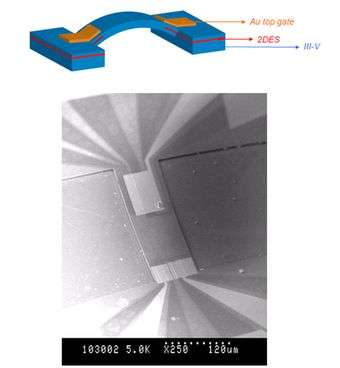May 2, 2008 feature
'Nanomechanical Oscillators' Could Lead to New Class of Computers

More than 50 years ago, a graduate student in Japan conceived the “Parametron,” an electrical circuit that could form the basis for digital computers. The concept ultimately fell flat, but recently a pair of scientists gave new life to the idea, and their work could be a first step toward a nanomechanical computer that is based on mechanical rather than electrical operations.
Rather than today's electronic “0” and “1” bits—the most basic pieces of information a computer can store, defined by whether a transistor has a zero or non-zero voltage across it—the Parametron used the response of an electrical oscillator to an applied frequency. The Parametron could only oscillate in two ways, a behavior that was exploited to represent 0's and 1's to enable binary logic.
Computers based on the Parametron were built, but the idea never took off as there were difficulties with power consumption and integration, and the much faster transistor quickly rendered it obsolete.
In the era of nanotechnology, the Parametron has been resurrected using mechanical oscillators. The scientists who have revived its spirit are Imran Mahboob and Hiroshi Yamaguchi of the NTT Corporation in Japan. Their electromechanical oscillator has a bridge-over-gap structure, and it's tiny: The gap is four micrometers deep and the bridge is 260 micrometers long, 84 micrometers wide, and 1.35 micrometers thick.
The bridge and the larger piece of material that contains the gap are made of the widely used semiconductor gallium arsenide (GaAs).
At the each end of the bridge, known as clamping points, there is a sandwich structure: a thin GaAs layer between a gold electrode and a “two-dimensional electronic system,” a general term for a material in which the electrons are confined to a plane.
When an alternating-current voltage that matches the bridge's natural frequency is applied across it, the bridge will oscillate vertically. This physical motion is due to a chain of events that begins with a displacement of atoms in the thin GaAs layer in response to the voltage. This causes the positive and negative charges in the layer to separate, which, in turn, produces a strain across the length of the bridge. The bridge bends slightly, a movement that can be tuned to a resonance frequency—there are more than one—by adjusting the voltage.
These resonance modes can be used to store information as bits. For example, neighboring oscillators with resonances that differ in phase—meaning they do not oscillate in unison—can represent 0 and 1 values.
“This is a highly tunable system, which we expect will make it easily integrable into complex architectures,” says Imran.
A nanomechanical computer based on his and Yamaguchi's concept would likely never be as fast as a transistor-based computer. But it would have some advantages, including being more resilient to electromagnetic shock and more energy efficient. This could make it a good replacement for computers that do not need to be ultra-fast, such as those in appliances, mobile phones, and cars.
Citation: I. Mahboob and H. Yamaguchi Nature Nanotechnology advance online publication, 13 April 2008 (DOI:10.1038/nnano.2008.84)
Copyright 2008 PhysOrg.com.
All rights reserved. This material may not be published, broadcast, rewritten or redistributed in whole or part without the express written permission of PhysOrg.com.





















